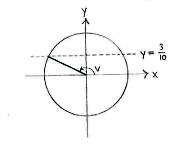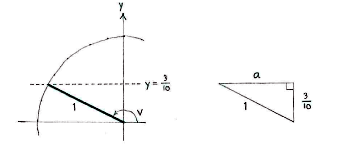Lösung 4.3:6b
Aus Online Mathematik Brückenkurs 1
(Unterschied zwischen Versionen)
K |
|||
| Zeile 1: | Zeile 1: | ||
| - | We draw an angle | + | We draw an angle <math>v</math> in the unit circle, and the fact that <math>\sin v = 3/10</math> means that its ''y''-coordinate equals <math>3/10</math>. |
| - | <math>v</math> | + | |
| - | in the unit circle, and the fact that | + | |
| - | <math>\ | + | |
| - | means that its | + | |
| - | + | ||
| - | -coordinate equals | + | |
| - | <math> | + | |
[[Image:4_3_6_b1.gif|center]] | [[Image:4_3_6_b1.gif|center]] | ||
| - | With the information that is given, we can define a right-angled triangle in the second quadrant which has a hypotenuse of | + | With the information that is given, we can define a right-angled triangle in the second quadrant which has a hypotenuse of 1 and a vertical side of length 3/10. |
| - | + | ||
| - | and a vertical side of length | + | |
| - | + | ||
| - | + | ||
| - | + | ||
[[Image:4_3_6_b2.gif|center]] | [[Image:4_3_6_b2.gif|center]] | ||
| - | We can determine the triangle's remaining side by using | + | We can determine the triangle's remaining side by using the Pythagorean theorem, |
| - | + | ||
| - | + | ||
| - | + | ||
| + | {{Displayed math||<math>a^2 + \Bigl(\frac{3}{10}\Bigr)^2 = 1^2</math>}} | ||
which gives that | which gives that | ||
| + | {{Displayed math||<math>a = \sqrt{1-\Bigl(\frac{3}{10}\Bigr)^2} = \sqrt{1-\frac{9}{100}} = \sqrt{\frac{91}{100}} = \frac{\sqrt{91}}{10}\,\textrm{.}</math>}} | ||
| - | <math> | + | This means that the angle's ''x''-coordinate is <math>-a</math>, i.e. we have |
| - | + | {{Displayed math||<math>\cos v=-\frac{\sqrt{91}}{10}</math>}} | |
| - | + | ||
| - | + | ||
| - | + | ||
| - | + | ||
| - | + | ||
| - | <math>\cos v=-\frac{\sqrt{91}}{10}</math> | + | |
and thus | and thus | ||
| - | + | {{Displayed math||<math>\tan v = \frac{\sin v}{\cos v} = \frac{\dfrac{3}{10}}{-\dfrac{\sqrt{91}}{10}} = -\frac{3}{\sqrt{91}}\,\textrm{.}</math>}} | |
| - | <math>\tan v=\frac{\sin v}{\cos v}=\frac{\ | + | |
Version vom 13:00, 10. Okt. 2008
We draw an angle \displaystyle v in the unit circle, and the fact that \displaystyle \sin v = 3/10 means that its y-coordinate equals \displaystyle 3/10.
With the information that is given, we can define a right-angled triangle in the second quadrant which has a hypotenuse of 1 and a vertical side of length 3/10.
We can determine the triangle's remaining side by using the Pythagorean theorem,
which gives that
This means that the angle's x-coordinate is \displaystyle -a, i.e. we have
and thus


